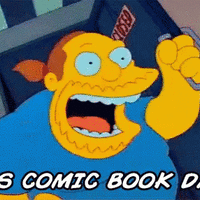More about Whaam!
- All
- Info
- Shop

Contributor
It’s not always the face of an artist that comes to mind when we hear their name.
It's usually that trademark/masterpiece/most-likely-to-end-up-on-a-postcard painting from the artist’s career that's conjured up in the ol’ noodle. So when I say Roy Lichtenstein, you say...Whaam!
This painting is probably the best known of Lichtenstein’s very long and prolific career. He churned out these oversized comic book numbers for as long as he could, and then some. Though some say Roy was one of the geniuses of the art world, there’s a fair number who call him a plagiarist. It’s because he didn’t do much besides blow up pre-existing images and modify them only slightly. Here’s the original for Whaam!, which comes from a 1962 issue of DC Comic’s All-American Men of War. I’ll let you guys decide from there whether he deserves to be called the P word or not. There are critics who say that he did the comic book artist a favor with this copy, because Lichtenstein’s way is bigger, better and way more effective. His version does in fact appear more explosive and violent with its thicker fiery flames and all emphasis on just that one onomatopoeic sound, WHAAM! instead of both WHAAM and WHOOSH.
Lichtenstein’s choice of war comic images may have had something to do with the fact that he had been a soldier in the U.S. army when he was around twenty years old. He never made it to actual combat, so he could’ve been making up for that with the paintings. He said he chose such images because they seemed macho and manly, and this was his tongue-in-cheek way of critiquing that masculine stereotype. It was also probably a reaction to the very macho movement of Abstract Expressionism championed by Jackson Pollock’s drippy, gestural strokes. Pop artists like Lichtenstein were kinda turned off by that whole gimmick and in response, Lichtenstein created a technique in which there was no evidence of the artists “hand”. Super controlled and mechanical compared to the acrobatics of guys like Pollock.
Whaam! was picked up by the Tate Gallery in London in 1966, for a measly £3,940 (around $10,000). Quite a steal for the Tate, because recently one of Lichtenstein’s works was auctioned off for about $43 million (!!!). Not all the Tate trustees were thrilled about this risqué purchase back in 1966, but they’re probably thanking their stars that they didn’t get their way. And they’re probably making a sweet penny in gift shop sales too…chalk one up for the Tate!
Featured Content
Here is what Wikipedia says about Whaam!
Whaam! is a 1963 diptych painting by the American artist Roy Lichtenstein. It is one of the best-known works of pop art, and among Lichtenstein's most important paintings. Whaam! was first exhibited at the Leo Castelli Gallery in New York City in 1963, and purchased by the Tate Gallery, London, in 1966. It has been on permanent display at Tate Modern since 2006.
The left-hand panel shows a fighter plane firing a rocket that, in the right-hand panel, hits a second plane which explodes in flames. Lichtenstein adapted the image from several comic-book panels, with the primary source being a panel illustrated by Irv Novick from a 1962 war comic book. Lichtenstein transformed the source by presenting it as a diptych while altering the relationship of the graphical and narrative elements. Whaam! is regarded for the temporal, spatial and psychological integration of its two panels. The painting's title is integral to the action and impact of the painting, and displayed in large onomatopoeia in the right panel.
Lichtenstein studied as an artist before and after serving in the United States Army during World War II. He practiced anti-aircraft drills during basic training, and he was sent for pilot training but the program was canceled before it started. Among the topics he tackled after the war were romance and war. He depicted aerial combat in several works. Whaam! is part of a series on war that he worked on between 1962 and 1964, and along with As I Opened Fire (1964) is one of his two large war-themed paintings.
Check out the full Wikipedia article about Whaam!














